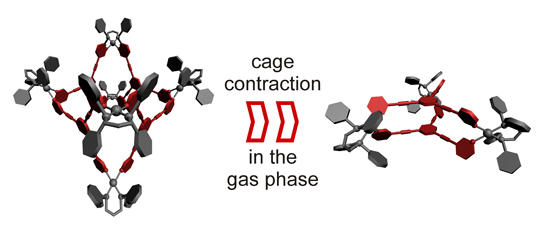Self-Assembly of Metallo-Supramolecular Polygons and Polyhedra
Self-assembly relies on building blocks that are suitably programmed with respect to the position and directionality of their binding sites which direct the assembly of many building blocks into one larger structure. Its formation is reversible so that error correction can occur, if binding sites have not been connected the most favorable way.
Among the metallo-supramolecular structures prepared and characterized in the group are simple polygons incorporating a number of identical ligands and metal centers, but also larger cages. In cooperation with the groups of Markus Albrecht and Jonathan Nitschke, mass spectrometry served as a tool to characterize even quite complex helicates and [7]catenanes and to follow their formation and dissociation pathways.
Chiral metallo-supramolecular polygons have been made some of which bear dynamically chiral bipyridyl ligands and show heterochiral self-sorting. Other chiral rhomboids have been deposited on surfaces to provide a means to structure the surface with chiral host molecules.
Some metallo-supramolecular oligomer chains even exhibit hierarchical self-assembly in that they grow into nanospheres and metallo-supramolecular vesicles.

A metallo-supramolecular cage undergoing a cage contraction in the gas phase
Related Publications
Metallo-Supramolecular Self-Assembly
-
180
Exploring the palladium and platinum bis(pyridyl) complex motif – do substituents affect NMR spectroscopic, X-ray crystallographic, (tandem) mass spectrometric, and isothermal titration calorimetry data following chemical intuition?
T. Weilandt, N.L. Löw, G. Schnakenburg, J. Daniels, M. Nieger, C.A. Schalley, A. Lützen
Chem. Eur. J.2012, 18, 16665-16676
-
174
Equipping metallo-supramolecular macrocycles with functional groups: Assemblies of pyridine-substituted urea ligands
R.W. Troff, R. Hovorka, T. Weilandt, A. Lützen, M. Cetina, M. Nieger, D. Lentz, K. Rissanen, C.A. Schalley
Dalton Trans. 2012, 41, 8410-8420
-
156
Effects of subtle differences in ligand constitution and conformation in metallo-supramolecular self-assembled polygons
B. Brusilowskij, E.V. Dzyuba, R.W. Troff, C.A. Schalley
Dalton Trans. 2011, 40, 12089-12096
-
149
Thermodynamically controlled self-sorting of hetero-bimetallic metallo-supramolecular macrocycles: What a difference a methylene group makes!
B. Brusilowskij, E. V. Dzyuba, R. W. Troff, C.A. Schalley
Chem. Commun. 2011, 47, 1830-1832
-
122
Self-assembly of heterodinuclear triple-stranded helicates: Control by coordination number and charge
M. Albrecht, Y. Liu, S.S. Zhu, C.A. Schalley, R. Fröhlich
Chem. Commun. 2009, 1195-1197
Chiral Metallo-Supramolecular Assemblies
-
114
Self-assembling squares with amino acid-decorated bipyridines: heterochiral self-sorting of dynamically interconverting diastereomers
A. Rang, M. Nieger, M. Engeser, A. Lützen, C.A. Schalley
Chem. Commun. 2008, 4789-4791
-
113
Metallo-Supramolecular Self-Assembly: the Case of Triangle-Square Equilibria
T. Weilandt, R.W. Troff, H. Saxell, K. Rissanen, C.A. Schalley
Inorg. Chem. 2008, 47, 7588-7598
-
110
Synthesis of Axially Chiral 4,4'-Bipyridines and their Remarkably Selective Self-Assembly into Chiral Metallo-Supramolecular Squares
A. Rang, M. Engeser, N.M. Maier, M. Nieger, W. Lindner, C.A. Schalley
Chem. Eur. J. 2008, 14, 3855-3859
-
86
Synthesis of Chiral Self-Assembling Rhombs and Their Characterization in Solution, in the Gas Phase, and at the Liquid-Solid Interface
K. S. Jeong, S. Y. Kim, U.-S. Shin, M. Kogej, N. T. M. Hai, P. Broekmann, N. Jeong, B. Kirchner, M. Reiher, C. A. Schalley
J. Am. Chem. Soc. 2005, 127, 17672-17685
Hierarchical Self-Assembly
-
128
Metallo-Supramolecular Nano-Spheres via Hierarchical Self-Assembly
H.T. Baytekin, B. Baytekin, A. Schulz, A. Springer, T. Gross, W. Unger, M. Artamonova, S. Schlecht, D. Lentz, C.A. Schalley
Chem. Mater. 2009, 21, 2980-2992
-
118
Hierarchical Self-Assembly of Metallo-Supramolecular Nano-Spheres
H. T. Baytekin, B. Baytekin, A. Schulz, C.A. Schalley
Small 2009, 5, 194-197
-
94
Dicatechol cis-dioxomolybdenum(VI): a building block for a lithium cation templated monomer-dimer equilibrium
M. Albrecht, M. Baumert, J. Klankermayer, M. Kogej, C. A. Schalley, R. Fröhlich
Dalton Trans. 2006, 4395-4400
-
81
Hierarchical Assembly of Helicate-Type Dinuclear Titanium(IV) Complexes
M. Albrecht, S. Mirtschin, M. de Groot, I. Janser, J. Runsink, G. Raabe, M. Kogej, C. A. Schalley, R. Fröhlich
J. Am. Chem. Soc. 2005, 127, 10371-10387
Gas-Phase Chemistry of Metallo-Supramolecular Assemblies
-
183
Generation of a Dynamic System of Three-Dimensional Tetrahedral Polycatenanes
S.P. Black, A.R. Stefankiewicz, M.M.J. Smulders, D. Sattler, C.A. Schalley, J.R. Nitschke, J.K.M. Sanders
Angew. Chem., 2013, 125, 5861-5864; Angew. Chem. Int. Ed., 2013, 52, 5749-5752
-
121
A double intramolecular cage contraction within a self-assembled metallo-supramolecular bowl
B. Brusilowskij, S. Neubacher, C.A. Schalley
Chem. Commun. 2009, 785-787
-
92
Helicate, Macrocycle, or Catenate: Dynamic Topological Control over Subcomponent Self-Assembly
M. Hutin, C. A. Schalley, G. Bernardinelli, J. R. Nitschke
Chem. Eur. J. 2006, 12, 4069-4076
-
44
Mass Spectrometric Characterization and Gas-Phase Chemistry of Self-Assembling Supramolecular Squares and Triangles
C. A. Schalley, T. Müller, P. Linnartz, M. Witt, M. Schäfer, A. Lützen
Chem. Eur. J. 2002, 8, 3538-3551


